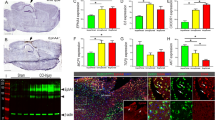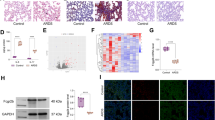Abstract
NUCB2/nesfatin-1 is expressed in variety of tissues. Treatment with nesfatin-1 reduces inflammation in rat models of subarachnoid hemorrhage-induced oxidative brain damage and traumatic brain injury as well as myocardial injury. There is only one study showing anti-inflammatory actions of nesfatin-1 on acute lung inflammation. To more precisely determine the role of NUCB2/nesfatin-1 in acute lung inflammation, we conducted a study using NUCB2/nesfatin-1 knockout (NKO) mice as well as neutrophils isolated from the bone marrows of WT and NKO mice. Our findings suggest that the absence of NUCB2/nesfatin-1 significantly increases the accumulation of adherent neutrophils by approximately 3 times compared with WT within LPS-treated lungs. Integrating this with observations from both BALF and neutrophil cytokine expression, we propose that although neutrophils lacking NUCB2/nesfatin-1 individually secrete less pro-inflammatory cytokines compared with stimulated WT cells, the result of knocking out NUCB2/nesfatin-1 is net pro-inflammatory. No change was found in NUCB2/nesfatin-1 mRNA or protein expression comparing WT LPS and PBS-treated samples. Taken together, our results show that NUCB2/nesfatin-1 is constitutively expressed in mouse lungs and neutrophils and demonstrates anti-inflammatory properties in mouse lungs during acute lung injury, by inhibiting adherent neutrophil accumulation and inflammatory cytokine expression.











Similar content being viewed by others
References
Bohmer RH, Trinkle LS, Staneck JL (1992) Dose effects of LPS on neutrophils in a whole blood flow cytometric assay of phagocytosis and oxidative burst. Cytometry 13:525–531
Cabanski M, Steinmuller M, Marsh LM, Surdziel E, Seeger W, Lohmeyer J (2008) PKR regulates TLR2/TLR4-dependent signaling in murine alveolar macrophages. Am J Respir Cell Mol Biol 38:26–31
Cao C, Chai Y, Shou S, Wang J, Huang Y, Ma T (2018) Toll-like receptor 4 deficiency increases resistance in sepsis-induced immune dysfunction. Int Immunopharmacol 54:169–176
Chen D, Cao S, Chang B, Ma T, Gao H, Tong Y, Li T, Han J, Yi X (2019) Increasing hypothalamic nucleobindin 2 levels and decreasing hypothalamic inflammation in obese male mice via diet and exercise alleviate obesity-associated hypogonadism. Neuropeptides 74:34–43
Chung Y, Jung E, Kim H, Kim J, Yang H (2013) Expression of nesfatin-1/NUCB2 in fetal, neonatal and adult mice. Dev Reprod 17:461–467
Doerschuk C (2000) Leukocyte trafficking in alveoli and airway passages. Respir Res 1:136–140
Eltom S, Belvisi MG, Yew-Booth L, Dekkak B, Maher SA, Dubuis ED, Jones V, Fitzgerald KA, Birrell MA (2014) TLR4 activation induces IL-1beta release via an IPAF dependent but caspase 1/11/8 independent pathway in the lung. Respir Res 15:87
He Y, Zhao Y, Feng Y, Ren A, Zhang Y, Wang Y, Li H (2020) Therapeutic effect and mechanism study of L-cysteine derivative 5P39 on LPS-induced acute lung injury in mice. Eur J Pharmacol 869:172893
Hong SY, Teng SW, Lin W, Wang CY, Lin HI (2020) Allogeneic human umbilical cord-derived mesenchymal stem cells reduce lipopolysaccharide-induced inflammation and acute lung injury. Am J Transl Res 12:6740–6750
Janardhan KS, Charavaryamath C, Aulakh GK, Singh B (2012) Integrin beta3 is not critical for neutrophil recruitment in a mouse model of pneumococcal pneumonia. Cell Tissue Res 348:177–187
Kanai Y, Miura K, Uehara T, Amagai M, Takeda O, Tanuma S, Kurosawa Y (1993) Natural occurrence of Nuc in the sera of autoimmune-prone MRL/lpr mice. Biochem Biophys Res Commun 196:729–736
Kyriazopoulou E, Leventogiannis K, Norrby-Teglund A, Dimopoulos G, Pantazi A, Orfanos SE, Rovina N, Tsangaris I, Gkavogianni T, Botsa E, Chassiou E, Kotanidou A, Kontouli C, Chaloulis P, Velissaris D, Savva A, Cullberg JS, Akinosoglou K, Gogos C, Armaganidis A, Giamarellos-Bourboulis EJ, Hellenic Sepsis Study G (2017) Macrophage activation-like syndrome: an immunological entity associated with rapid progression to death in sepsis. BMC Med 15:172
Leivo-Korpela S, Lehtimaki L, Hamalainen M, Vuolteenaho K, Koobi L, Jarvenpaa R, Kankaanranta H, Saarelainen S, Moilanen E (2014) Adipokines NUCB2/nesfatin-1 and visfatin as novel inflammatory factors in chronic obstructive pulmonary disease. Mediators Inflamm 2014:232167
Levin J, Poore TE, Zauber NP, Oser RS (1970) Detection of endotoxin in the blood of patients with sepsis due to gram-negative bacteria. N Engl J Med 283:1313–1316
Lorenz E, Jones M, Wohlford-Lenane C, Meyer N, Frees KL, Arbour NC, Schwartz DA (2001) Genes other than TLR4 are involved in the response to inhaled LPS. Am J Physiol Lung Cell Mol Physiol 281(5):L1106–L1114
Matthay MA, Ware LB, Zimmerman GA (2012) The acute respiratory distress syndrome. J Clin Investig 122:2731–2740
Matthay MA, Zemans RL, Zimmerman GA, Arabi YM, Beitler JR, Mercat A, Herridge M, Randolph AG, Calfee CS (2019) Acute respiratory distress syndrome. Nat Rev Dis Primers 5:18
Matute-Bello G, Frevert CW, Martin TR (2008) Animal models of acute lung injury. Am J Physiol Lung Cell Mol Physiol 295:L379-399
Monzon ME, Forteza RM, Casalino-Matsuda SM (2011) MCP-1/CCR2B-dependent loop upregulates MUC5AC and MUC5B in human airway epithelium. Am J Physiol Lung Cell Mol Physiol 300:L204-215
Oh IS, Shimizu H, Satoh T, Okada S, Adachi S, Inoue K, Eguchi H, Yamamoto M, Imaki T, Hashimoto K, Tsuchiya T, Monden T, Horiguchi K, Yamada M, Mori M (2006) Identification of nesfatin-1 as a satiety molecule in the hypothalamus. Nature 443:709–712
Ozsavci D, Ersahin M, Sener A, Ozakpinar OB, Toklu HZ, Akakin D, Sener G, Yegen BC (2011) The novel function of nesfatin-1 as an anti-inflammatory and antiapoptotic peptide in subarachnoid hemorrhage-induced oxidative brain damage in rats. Neurosurgery 68:1699–1708; discussion 1708
Potera RM, Cao M, Jordan LF, Hogg RT, Hook JS, Moreland JG (2019) Alveolar macrophage chemokine secretion mediates neutrophilic lung injury in Nox2-deficient mice. Inflammation 42:185–198
Prinz P, Goebel-Stengel M, Teuffel P, Rose M, Klapp BF, Stengel A (2016) Peripheral and central localization of the nesfatin-1 receptor using autoradiography in rats. Biochem Biophys Res Commun 470:521–527
Scotece M, Conde J, Abella V, Lopez V, Lago F, Pino J, Gomez-Reino JJ, Gualillo O (2014) NUCB2/nesfatin-1: a new adipokine expressed in human and murine chondrocytes with pro-inflammatory properties, an in vitro study. J Orthop Res 32:653–660
Singh B, Pearce JW, Gamage LN, Janardhan K, Caldwell S (2004) Depletion of pulmonary intravascular macrophages inhibits acute lung inflammation. Am J Physiol: Lung Cell Mol Physiol 286:L363–L372
Stengel A, Tache Y (2012) Gastric peptides and their regulation of hunger and satiety. Curr Gastroenterol Rep 14:480–488
Suratt BT, Parsons PE (2006) Mechanisms of acute lung injury/acute respiratory distress syndrome. Clin Chest Med 27:579–589; abstract viii
Tang CH, Fu XJ, Xu XL, Wei XJ, Pan HS (2012) The anti-inflammatory and anti-apoptotic effects of nesfatin-1 in the traumatic rat brain. Peptides 36:39–45
Togbe D, Schnyder-Candrian S, Schnyder B, Doz E, Noulin N, Janot L, Secher T, Gasse P, Lima C, Coelho FR, Vasseur V, Erard F, Ryffel B, Couillin I, Moser R (2007) Toll-like receptor and tumour necrosis factor dependent endotoxin-induced acute lung injury. Int J Exp Pathol 88:387–391
Vrolyk V, Schneberger D, Le K, Wobeser BK, Singh B (2019) Mouse model to study pulmonary intravascular macrophage recruitment and lung inflammation in acute necrotizing pancreatitis. Cell Tissue Res 378:97–111
Walker F, Zhang HH, Matthews V, Weinstock J, Nice EC, Ernst M, Rose-John S, Burgess AW (2008) IL6/sIL6R complex contributes to emergency granulopoietic responses in G-CSF- and GM-CSF-deficient mice. Blood 111:3978–3985
Wang ZZ, Chen SC, Zou XB, Tian LL, Sui SH, Liu NZ (2020) Nesfatin-1 alleviates acute lung injury through reducing inflammation and oxidative stress via the regulation of HMGB1. Eur Rev Med Pharmacol Sci 24:5071–5081
World Health Organization (2017) The top 10 causes of death. Retrieved from http://www.who.int/mediacentre/factsheets/fs310/en/
Wright HL, Cross AL, Edwards SW, Moots RJ (2014) Effects of IL-6 and IL-6 blockade on neutrophil function in vitro and in vivo. Rheumatology (Oxford) 53:1321–1331
Yoshimura T, Imamichi T, Weiss JM, Sato M, Li L, Matsukawa A, Wang JM (2016) Induction of monocyte chemoattractant proteins in macrophages via the production of granulocyte/macrophage colony-stimulating factor by breast cancer cells. Front Immunol 7:2
Zemans RL, Colgan SP, Downey GP (2009) Transepithelial migration of neutrophils: mechanisms and implications for acute lung injury. Am J Respir Cell Mol Biol 40:519–535
Zhao X, Zmijewski JW, Lorne E, Liu G, Park YJ, Tsuruta Y, Abraham E (2008) Activation of AMPK attenuates neutrophil proinflammatory activity and decreases the severity of acute lung injury. Am J Physiol Lung Cell Mol Physiol 295:L497–504
Funding
Baljit Singh’s laboratory is supported with a Discovery Grant from Natural Sciences and Engineering Research Council of Canada. Funding for the laboratory of Suraj Unniappan is supported by an open operating grant from the Canadian Institutes of Health Research, an establishment grant from the Saskatchewan Health Research Foundation, John Evans Leaders Fund from the Canada Foundation for Innovation and from the University of Saskatchewan through the Centennial Enhancement Chair in Comparative Endocrinology. Gurpreet Aulakh's work is supported through Sylvia Fedoruk Centre for Nuclear Innovation Chair in Nuclear Imaging.
Author information
Authors and Affiliations
Corresponding author
Ethics declarations
Ethics
All applicable national guidelines for the care and use of animals were followed and all the experiments were approved by the Animal Ethics Board of University of Saskatchewan.
Conflict of interest
The authors declare that they have no conflict of interest.
Additional information
Publisher’s Note
Springer Nature remains neutral with regard to jurisdictional claims in published maps and institutional affiliations.
Supplementary Information
Below is the link to the electronic supplementary material.
Rights and permissions
About this article
Cite this article
Hui, J., Aulakh, G.K., Unniappan, S. et al. Loss of Nucleobindin-2/Nesfatin-1 increases lipopolysaccharide-induced murine acute lung inflammation. Cell Tissue Res 385, 87–103 (2021). https://doi.org/10.1007/s00441-021-03435-6
Received:
Accepted:
Published:
Issue Date:
DOI: https://doi.org/10.1007/s00441-021-03435-6




